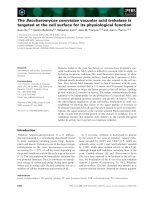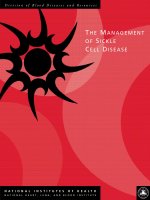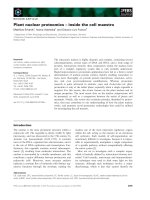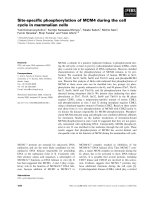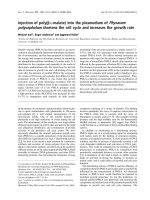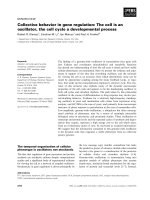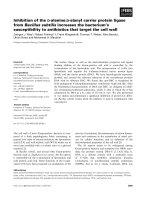The cell cycle_chu_ki_te_bao_phan_bao
Bạn đang xem bản rút gọn của tài liệu. Xem và tải ngay bản đầy đủ của tài liệu tại đây (284.48 KB, 10 trang )
The cell cycle
Actively dividing eukaryote cells pass through a series of stages known collectively as
the cell cycle: two gap phases (G1 and G2); an S (for synthesis) phase, in which the
genetic material is duplicated; and an M phase, in which mitosis partitions the genetic
material and the cell divides.
G1 phase. Metabolic changes prepare the cell for division. At a certain point - the
restriction point - the cell is committed to division and moves into the S phase.
S phase. DNA synthesis replicates the genetic material. Each chromosome now
consists of two sister chromatids.
G2 phase. Metabolic changes assemble the cytoplasmic materials necessary for
mitosis and cytokinesis.
M phase. A nuclear division (mitosis) followed by a cell division (cytokinesis).
The period between mitotic divisions - that is, G1, S and G2 - is known as interphase.
Mitosis
Mitosis is a form of eukaryotic cell division that produces two daughter cells with the
same genetic component as the parent cell. Chromosomes replicated during the S phase
are divided in such a way as to ensure that each daughter cell receives a copy of every
chromosome. In actively dividing animal cells, the whole process takes about one hour.
The replicated chromosomes are attached to a 'mitotic apparatus' that aligns them and
then separates the sister chromatids to produce an even partitioning of the genetic
material. This separation of the genetic material in a mitotic nuclear division
(or karyokinesis) is followed by a separation of the cell cytoplasm in a cellular division
(or cytokinesis) to produce two daughter cells.
In some single-celled organisms mitosis forms the basis of asexual reproduction. In
diploid multicellular organisms sexual reproduction involves the fusion of two haploid
gametes to produce a diploid zygote. Mitotic divisions of the zygote and daughter cells
are then responsible for the subsequent growth and development of the organism. In the
adult organism, mitosis plays a role in cell replacement, wound healing and tumour
formation.
Mitosis, although a continuous process, is conventionally divided into five stages:
prophase, prometaphase, metaphase, anaphase and telophase.
The phases of mitosis
Prophase
Prophase occupies over half of mitosis. The nuclear membrane breaks down to form a
number of small vesicles and the nucleolus disintegrates. A structure known as
the centrosomeduplicates itself to form two daughter centrosomes that migrate to
opposite ends of the cell. The centrosomes organise the production of microtubules that
form the spindle fibres that constitute the mitotic spindle. The chromosomes condense
into compact structures. Each replicated chromosome can now be seen to consist of two
identical chromatids (or sister chromatids) held together by a structure known as
the centromere.
Prometaphase
The chromosomes, led by their centromeres, migrate to the equatorial plane in the midline of the cell - at right-angles to the axis formed by the centrosomes. This region of the
mitotic spindle is known as the metaphase plate. The spindle fibres bind to a structure
associated with the centromere of each chromosome called a kinetochore. Individual
spindle fibres bind to a kinetochore structure on each side of the centromere. The
chromosomes continue to condense.
Metaphase
The chromosomes align themselves along the metaphase plate of the spindle apparatus.
Anaphase
The shortest stage of mitosis. The centromeres divide, and the sister chromatids of each
chromosome are pulled apart - or 'disjoin' - and move to the opposite ends of the cell,
pulled by spindle fibres attached to the kinetochore regions. The separated sister
chromatids are now referred to as daughter chromosomes. (It is the alignment and
separation in metaphase and anaphase that is important in ensuring that each daughter
cell receives a copy of every chromosome.)
Telophase
The final stage of mitosis, and a reversal of many of the processes observed during
prophase. The nuclear membrane reforms around the chromosomes grouped at either pole
of the cell, the chromosomes uncoil and become diffuse, and the spindle fibres disappear.
Cytokinesis
The final cellular division to form two new cells. In plants a cell plate forms along the
line of the metaphase plate; in animals there is a constriction of the cytoplasm. The cell
then enters interphase - the interval between mitotic divisions.
Meiosis
Meiosis is the form of eukaryotic cell division that produces haploid sex cells or gametes
(which contain a single copy of each chromosome) from diploid cells (which contain two
copies of each chromosome). The process takes the form of one DNA replication
followed by two successive nuclear and cellular divisions (Meiosis I and Meiosis II). As
in mitosis, meiosis is preceded by a process of DNA replication that converts each
chromosome into two sister chromatids.
Meiosis I
Meiosis I separates the pairs of homologous chromosomes.
In Meiosis I a special cell division reduces the cell from diploid to haploid.
Prophase I
The homologous chromosomes pair and exchange DNA to form recombinant
chromosomes. Prophase I is divided into five phases:
Leptotene: chromosomes start to condense.
Zygotene: homologous chromosomes become closely associated (synapsis) to
form pairs of chromosomes (bivalents) consisting of four chromatids (tetrads).
Pachytene: crossing over between pairs of homologous chromosomes to form
chiasmata (sing. chiasma).
Diplotene: homologous chromosomes start to separate but remain attached by
chiasmata.
Diakinesis: homologous chromosomes continue to separate, and chiasmata move
to the ends of the chromosomes.
Prometaphase I
Spindle apparatus formed, and chromosomes attached to spindle fibres by kinetochores.
Metaphase I
Homologous pairs of chromosomes (bivalents) arranged as a double row along the
metaphase plate. The arrangement of the paired chromosomes with respect to the poles of
the spindle apparatus is random along the metaphase plate. (This is a source of genetic
variation through random assortment, as the paternal and maternal chromosomes in a
homologous pair are similar but not identical. The number of possible arrangements is 2 n,
where n is the number of chromosomes in a haploid set. Human beings have 23 different
chromosomes, so the number of possible combinations is 223, which is over 8 million.)
Anaphase I
The homologous chromosomes in each bivalent are separated and move to the opposite
poles of the cell
Telophase I
The chromosomes become diffuse and the nuclear membrane reforms.
Cytokinesis
The final cellular division to form two new cells, followed by Meiosis II. Meiosis I is a
reduction division: the original diploid cell had two copies of each chromosome; the
newly formed haploid cells have one copy of each chromosome.
Meiosis II
Meiosis II separates each chromosome into two chromatids.
The events of Meiosis II are analogous to those of a mitotic division, although the
number of chromosomes involved has been halved.
Meiosis generates genetic diversity through:
the exchange of genetic material between homologous chromosomes during
Meiosis I
the random alignment of maternal and paternal chromosomes in Meiosis I
the random alignment of the sister chromatids at Meiosis II
Meiosis in females
